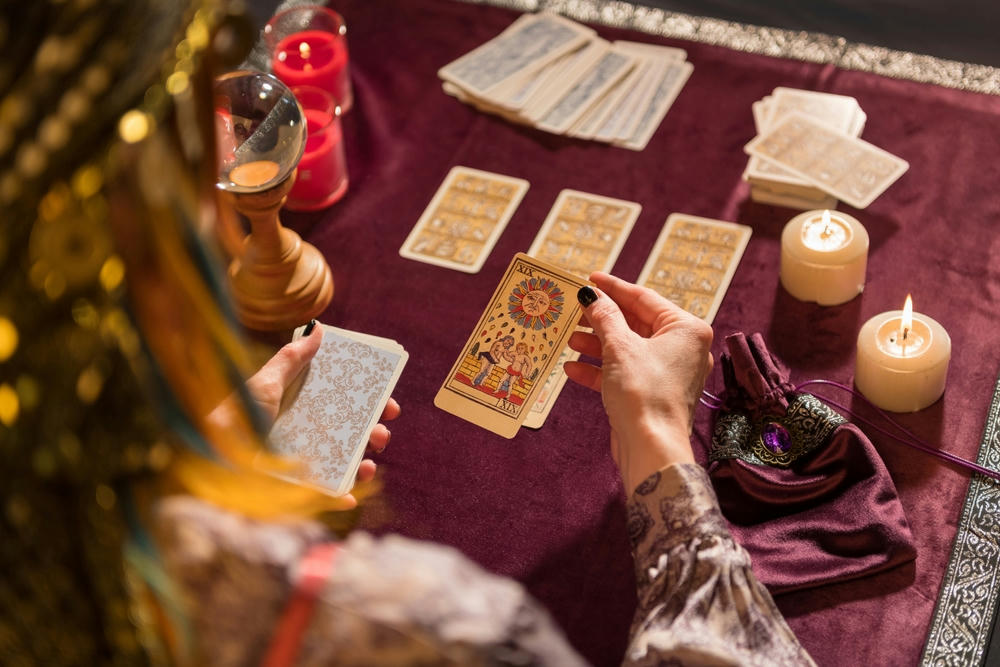
The Best Tarot Card Spreads For Beginners
Ready to kickstart your tarot reading journey? Our guide to beginner tarot spreads is for you!
From simple one-card pulls to the intricate Celtic Cross, we'll guide you through some of the easiest and best spreads, lighting the way on your path to tarot and beyond.

Top five tarot spreads for beginners
Let's start by introducing you to five tarot spreads for beginners. Designed to be both easy and enlightening, these spreads provide seekers with a clear and insightful entry point into their tarot journey.
When you’re learning how to read tarot cards, it’s important to remember that, for every spread, we must begin by clearing our minds. While shuffling the deck, maintain your intent, and energy, and keep focused on your question. For beginners, it's advised to begin with simple questions during a tarot reading before moving on to more complex ones.
One Card Pull
The One Card Pull is a simple yet powerful tarot spread, especially beneficial for gaining quick insights. For beginners exploring what tarot cards are, this spread is an excellent way to learn and build a strong connection with your deck. You’ll soon become familiar with the tarot cards, their unique messages, and how to apply them to different contexts.
Here's a two-step guide on how to perform a one-card pull:
- Stop shuffling and draw a card
Stop shuffling and draw one card from the deck when you feel ready or intuitively guided. You can do this by spreading the cards and selecting one randomly or cutting the deck and drawing the top card.
- Interpret the card
Examine the drawn card, paying attention to the imagery, symbols, and emotions it evokes. Consider both the traditional meanings of the card and trust your intuition in interpreting its message.
Here are some additional tips to enhance your one-card pull experience:
-
Assign daily themes
Make your one-card pull more engaging by assigning specific themes to each day of the week (e.g., Monday for career, Tuesday for love). Pull a card daily to gain insights related to the chosen theme for that day.
-
Observe every detail
When examining the card, scrutinise the symbols, colours, numbers, and time-related aspects (seasons, moon phases, day/night). These elements add depth to your insight, elevating the reading even with just one card.
-
Take a moment for meditation
Take a moment to meditate on the card. Close your eyes, focus on your breath, and let the card's imagery guide your thoughts. Consider the tone it sets for your day and how its message might unfold in your life. This deepens your connection with the one-card pull practice and the card's message.
Three Card Spread
The Three Card Spread is great for beginners due to its straightforward nature. With a clear past, present, and future structure, this spread promotes reflection, encouraging beginners to consider the context and connections between the cards.
Once you’ve shuffled…
- Cut the deck
When you feel ready, you can optionally cut the deck into three stacks. Some readers find this step adds a personal touch to the process.
- Draw three cards
Draw three cards from the top of the deck, placing them side by side in a row.
- Position the cards
Assign a specific position to each card:- Card 1 (Left): Represents the past or influences leading to the current situation.
- Card 2 (Center): Reflects the present situation or the main challenge.
- Card 3 (Right): Symbolises the future or potential outcomes.
- Interpret the spread
Examine each card individually, considering its imagery, symbolism, and traditional meanings. Note the relationships between the cards and observe how they tell a cohesive story.

Celtic Cross Spread
This spread is good for beginners as it deepens the understanding of the tarot.
Executing the Celtic Cross Spread may seem more complex due to its ten-card layout, but the effort is worthwhile for a comprehensive analysis of a situation. Once the layout is organised, and each card has a designated position, it becomes easy to follow with practice.
Let's explore how to execute the Celtic Cross Spread:
- Cut the deck
Cut the deck into two stacks.
- Draw the first card
Draw the first card from the top of the deck and place it in the centre of your reading area. This card represents the present situation or the heart of the matter.
- Draw the next four cards
Place the next four cards in a vertical line above the centre card:- Card 2 (Crossing): Challenges or obstacles.
- Card 3 (Below): Subconscious influences.
- Card 4 (Behind): Past influences.
- Card 5 (Above): Conscious influences or goals.
- Draw the next four cards in a horizontal line
Place the next four cards in a horizontal line to the right of the centre card.
Cards 6, 7, 8, 9 (Around the Cross): Immediate future and external influences.
- Draw the final card
Place the final card to the right of the horizontal line.
Card 10 (Outcome): Indicates the potential outcome or resolution.
- Interpret the spread
Begin interpreting each card, starting with the centre card. Pay close attention to the relationships between the cards, observing any patterns or emerging themes.
Take note of overlapping or connecting cards within the spread, as these points of intersection often indicate a special connection or influence between the cards, unravelling a more intricate layer of meaning in the reading.
Relationship Spread
Crafting a relationship spread in tarot means organising cards in a layout designed for questions about love and relationships — whether it’s romantic, familial, or friendship. It's straightforward and can mirror the simplicity of a three-card spread, offering an easy-to-follow structure.
This spread introduces flexibility, allowing beginners to adapt and gradually build confidence in tarot interpretation. As you become more familiar, you can explore more intricate relationship insights by adding extra card positions. However, let's begin with a simple approach for now:
- Cut the deck
When you feel ready, cut the deck into two stacks.
- Draw the cards
Draw a specific number of cards based on the layout you choose for your relationship spread. A common and simple layout involves three cards.
- Position the cards (example for a three-card relationship spread)
- Card 1: Represents you or your current state in the relationship.
- Card 2: Represents your partner or their current state in the relationship.
- Card 3: Represents the relationship dynamics or potential future.
- Interpret the spread
Delve into the insights offered by each card, considering their assigned roles in shedding light on various aspects of the relationship.
Leverage the spread as a tool to explore the potential for transformation and evolution within the relationship, allowing any interconnected cards to unveil deeper layers of understanding and guidance.

Decision Spread
The Decision Spread is a straightforward and versatile tarot card reading suitable for any question, problem, or decision you wish to explore. This makes it an accessible option for beginners, offering a simple yet effective way to engage with tarot.
Seekers can dedicate positions to highlight different factors influencing the decision-making process. This can include aspects such as emotions, logic, intuition, external influences, and long-term consequences. Each card provides a lens through which to view these factors.
Here's a straightforward guide on how to perform a decision spread:
- Cut the deck
Split the deck into two stacks.
- Draw the cards
Design a spread based on the number of options or factors in your decision. A simple three-card spread is a good starting point.
- Position the cards (example for a three-card relationship spread)
- Card 1: Option 1 - Insights or influences related to the first choice.
- Card 2: Option 2 - Insights or influences related to the second choice.
- Card 3: Guidance or Outcome - What the tarot suggests or the potential outcome of each choice.
- Interpret the spread
Analyse each card individually and then consider how their interpretations collectively provide a comprehensive perspective on the decision.
Always keep the context in mind when working with spreads like these. Relate the interpretations to the specific details of the decision you are struggling to make.
Three ways to develop confidence in tarot card reading
Building confidence in tarot card reading, especially for beginners, involves a combination of practice, intuition, and a positive mindset. Here are three tips to help you boost your confidence:

-
Start small and gradual
Start your tarot journey by beginning with simple, one-card pulls or small spreads. Concentrate on grasping the meanings of individual cards before delving into more complex layouts. Take the time to build a relationship with the cards gradually.
Why not allocate a few moments each day to pull a single card and reflect on its significance? -
Study symbolism and imagery
Devote time to studying the symbolism and imagery in each card. Grasping the visual cues and symbols can enrich your interpretations. Pay close attention to the details in the artwork, as they frequently offer subtle clues and nuances that enhance your readings. The more acquainted you become with the symbolism, the more confident you'll be in interpreting the cards. -
Practice regularly with diverse decks
As you become more confident, try out different tarot decks to experience various artistic styles and interpretations. Each deck interprets card meanings differently, broadening your overall understanding of tarot.
Regularly practising with diverse decks improves your versatility in readings and helps you adapt to the unique energies and vibes each deck brings.
Conclusion
Embark on your spiritual journey with confidence and curiosity, using these beginner-friendly spreads as stepping stones to the tarot. Embrace the cards, trust your insights, and let the magic of tarot illuminate your path.
Remember, tarot reading is a personal and intuitive practice with no one-size-fits-all approach. Give yourself the freedom to explore, make mistakes, and learn from your experiences. Building confidence is a gradual process, so enjoy the journey of self-discovery and trust in your ability to connect with the cards.
If the information in this blog isn’t enough to nourish your spirit, consider exploring cartomancy to discover other mystical ways cards can reveal insights about our future!
More predictions and horoscopes
Learn more about your love life, career and future and try another free horoscope on PsychicWorld.
All free horoscopes All year horoscopes Today's horoscope
Need expert help and a personal reading?
Chat with an online psychic expert and make 2023 your year!
*Image(s) used under license from Shutterstock.com and / or stock.adobe.com